The flight from Kupang to Bajawa took under one hour by ATR72-600, a turbo-prop commuter craft that is commonly used for the short and sometimes difficult runways of eastern Indonesia. At Bajawa’s tiny airport we were met by a bevy of local kabupaten officials, then whisked away in a police-lead motor cavalcade, sirens blaring, to the Bupati’s office. It turned out to be a slightly run-down building in the centre of town. It looked like a high school in need of renovation.
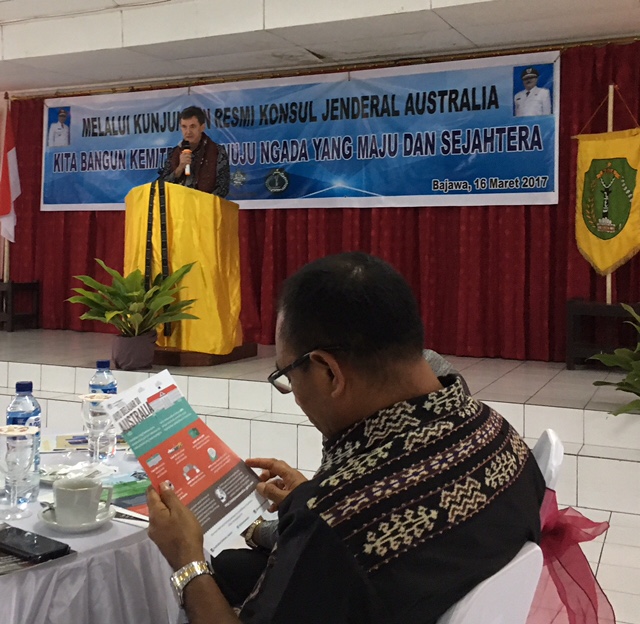 Marianus Sae is the Bupati of Ngada Regency (pop 178,000). He is fluent in English, Indonesian, Balinese and his mother tongue, Bajawan. On our arrival he greeted Putri in Balinese: Sapunapi ortine, Bu? Pak Marianus was a businessman before entering politics, and spent 25 years in Bali running a number of construction and property-related enterprises. He apologized to us for the state of his office, saying he couldn’t yet afford a new Kantor Bupati because he still had to fund many projects for his communities. This was touching: in other kabupaten I have visited usually the biggest, grandest building in town was the newly-constructed Kantor Bupati.
Marianus Sae is the Bupati of Ngada Regency (pop 178,000). He is fluent in English, Indonesian, Balinese and his mother tongue, Bajawan. On our arrival he greeted Putri in Balinese: Sapunapi ortine, Bu? Pak Marianus was a businessman before entering politics, and spent 25 years in Bali running a number of construction and property-related enterprises. He apologized to us for the state of his office, saying he couldn’t yet afford a new Kantor Bupati because he still had to fund many projects for his communities. This was touching: in other kabupaten I have visited usually the biggest, grandest building in town was the newly-constructed Kantor Bupati.
Marianus is a jolly and genuine person. When he spoke to local audiences he broke into Bajawan and made everyone laugh: I am sure he was cracking very earthy jokes. He introduced me over lunch to his senior staff and spoke of his policies for developing his kabupaten. He has encouraged mountain villages to compete with each other to build roads; he has supported students to study in Kupang with scholarships; he has helped build up the coffee industry – Flores Arabica is known around the world.
Indeed, the kabupaten of Ngada is a fertile agriculture district: almost anything grows in its rich black volcanic soil. Ngada could feed itself without the rest of the world. But the Ngada government relies on the Jakarta central government for around 95 per cent of its revenue. Little tax can be collected locally because there are very few businesses, and most people are subsistence farmers.
After lunch Pak Marianus accompanied us to a school built under the Australia-Indonesia Education Partnership, Bajawa Junior High School One. It was drizzling but a group of children dressed in traditional ikat costumes welcomed us: a boy roared a welcome dedication while waving about a very long sword; then the rest of the children danced a gentle shuffle to a small gong orchestra as we moved up the road to the school. The kids had been waiting for us since morning. (See my video here: https://www.facebook.com/KonJenMakassar/videos/1140089569453755/).
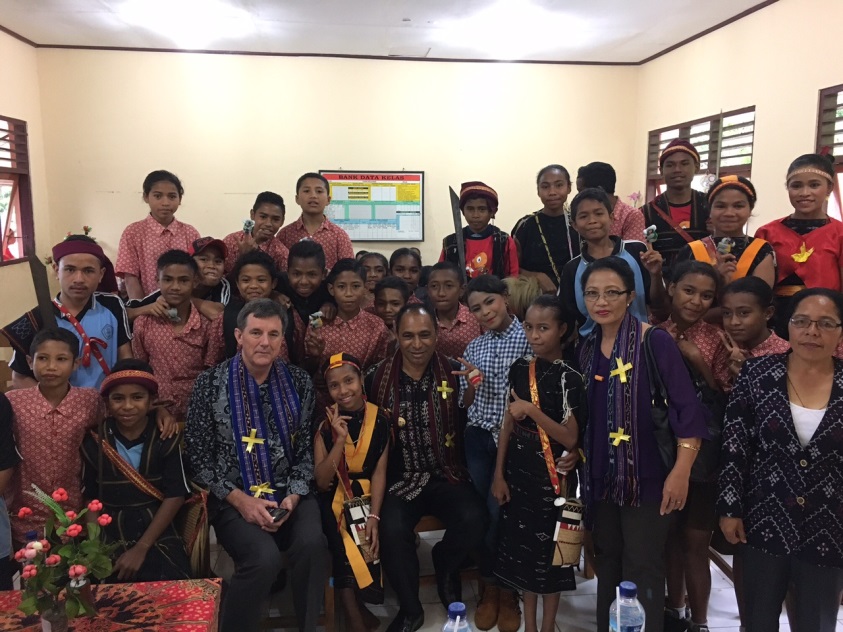 The school was similar to 2,724 other schools that Australia has helped build over the past ten years around Indonesia. There are 29 such schools in Ngada regency alone. I was very happy to meet the principal, Ibu Wunu, and hear how the community were keen to see this school produce more successful graduates. My pep talk to the kids included a short quiz on geography, and Putri handed out little koala bears to the winners. In the end all the children present got a koala. So did Pak Marianus and some of his officials.
The school was similar to 2,724 other schools that Australia has helped build over the past ten years around Indonesia. There are 29 such schools in Ngada regency alone. I was very happy to meet the principal, Ibu Wunu, and hear how the community were keen to see this school produce more successful graduates. My pep talk to the kids included a short quiz on geography, and Putri handed out little koala bears to the winners. In the end all the children present got a koala. So did Pak Marianus and some of his officials.
Our next stop together was a group of women supported by the Koalisi Perempuan Indonesia, an NGO supported by Oxfam Australia. In this world of delegating, DFAT supports Oxfam which supports women's empowerment NGOs in Indonesia, who support local women's activist groups who help poor women learn how to be more assertive, demand their rights and access public services (I know it sounds complicated, but it works). It is always fascinating to hear these women’s stories, and with Pak Marianus present even more enlightening. At the end of our meeting he said he was so impressed he would henceforth favour women’s groups for local government-funded projects, they were more credible and reliable.
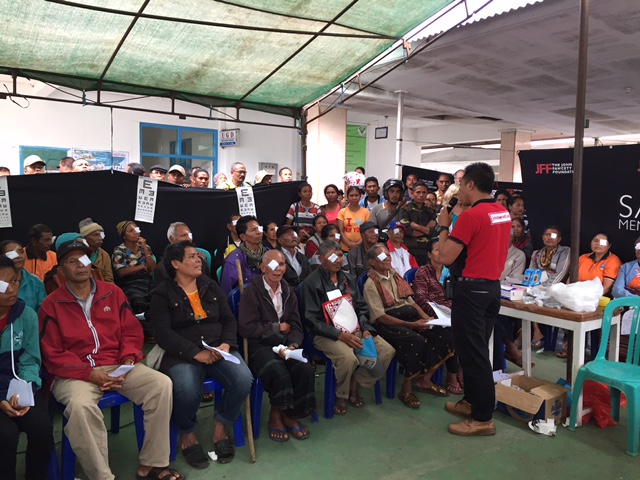 The next morning was our key event in Bajawa: observing a mobile eye clinic we have helped fund, organized by the Bali-based John Fawcett Foundation at the Bajawa district hospital. There are basic medical facilities but no ophthalmologists in Ngada. The hospital looked a bit like a rambling high school building – like the Bupati’s office. Patients with eye problems in Bajawa have to wait until a JFF or similar mobile eye clinic arrives before they can be seen to. JFF had brought along a lot of equipment, plus two specialist volunteer eye doctors. Most of the organising staff are Balinese, and were impressive and dedicated young folk.
The next morning was our key event in Bajawa: observing a mobile eye clinic we have helped fund, organized by the Bali-based John Fawcett Foundation at the Bajawa district hospital. There are basic medical facilities but no ophthalmologists in Ngada. The hospital looked a bit like a rambling high school building – like the Bupati’s office. Patients with eye problems in Bajawa have to wait until a JFF or similar mobile eye clinic arrives before they can be seen to. JFF had brought along a lot of equipment, plus two specialist volunteer eye doctors. Most of the organising staff are Balinese, and were impressive and dedicated young folk.
Pak Marianus gave a rousing talk to the mainly old folk waiting for their eyes to recover from the cataract operations. My speech was a poor second but also raised a few laughs. These folk were incredibly grateful, and resilient. Some had been waiting for years to have their eyes fixed. Gowned and scrubbed up, I watched the eye surgeon remove a cataracted lens and replace it with a new, clear synthetic one. The operation took only a few minutes.
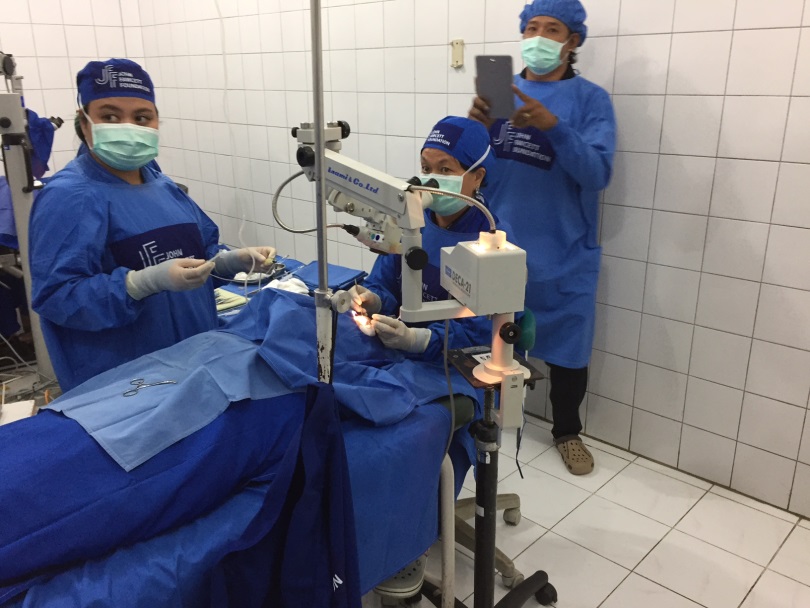
A Perth-based charity, the Flores Village Partners, also support the JFF in this work, and they interviewed me about the value of supporting such field work. After seeing what the JFF is doing, I couldn’t praise this work enough.

The highlight of our trip to Ngada was a visit to the traditional village of Bena in the gorgeous Jerebuu valley. Bena is one of several old villages in this valley where the wooden houses are built with tall thatched roofs, aligned north-south along a ridge with a large public space in the middle where great stone tombs contain the remains of ancestors.
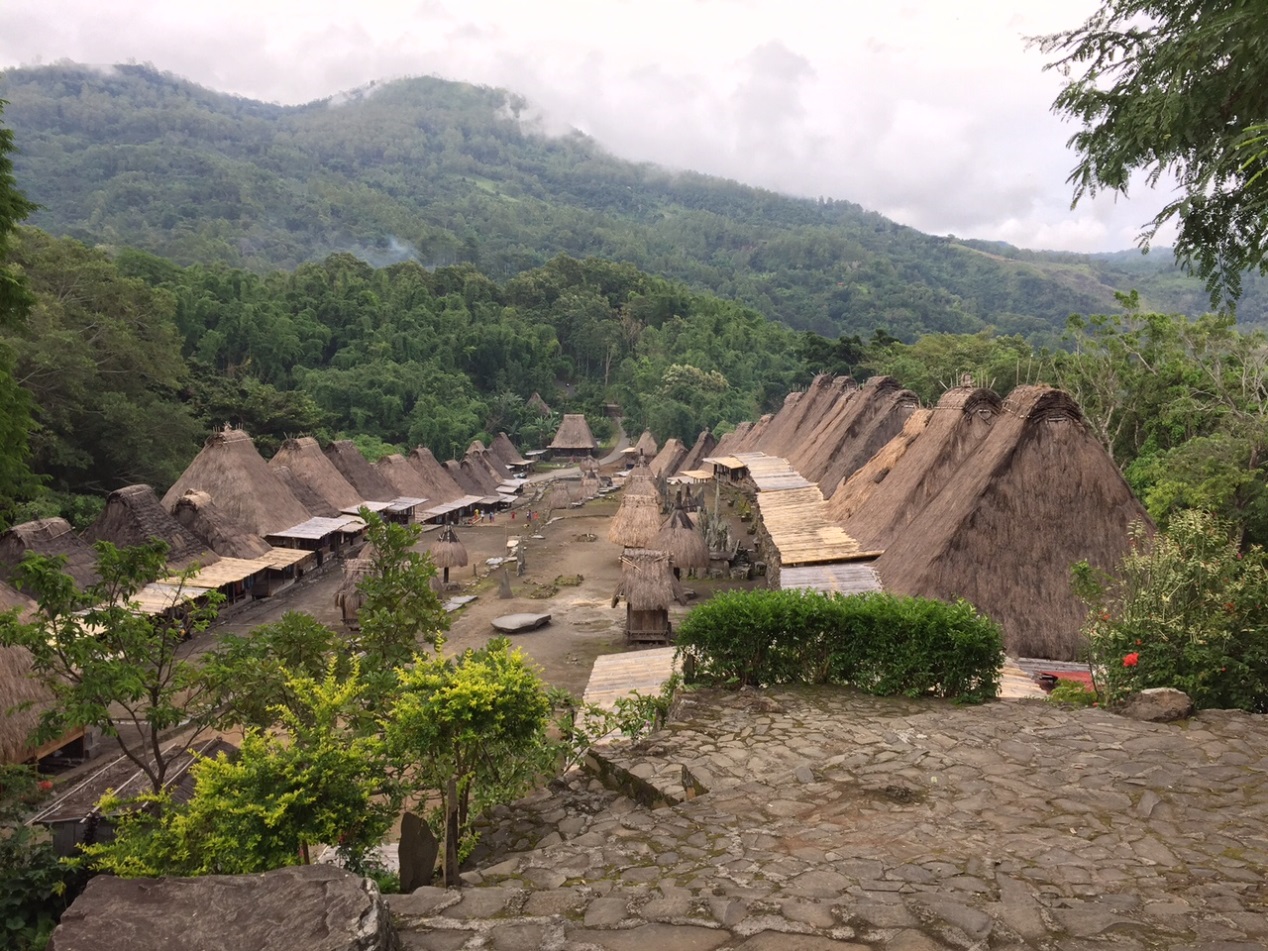
The ladies were all at work with back-strap looms making traditional ikat cloths; the boys were playing a traditional spinning top game called gasing; the girls were jumping long elastic bands. It was a scene from old Flores, and the people were enjoying themselves too. But there were no teenagers that I could see. Most were probably in town hanging about with friends. In a “traditional” village there is little to keep modern teenagers interested. Despite the fact that behind every traditional house in Bena, as Putri pointed out, there was a satellite dish.
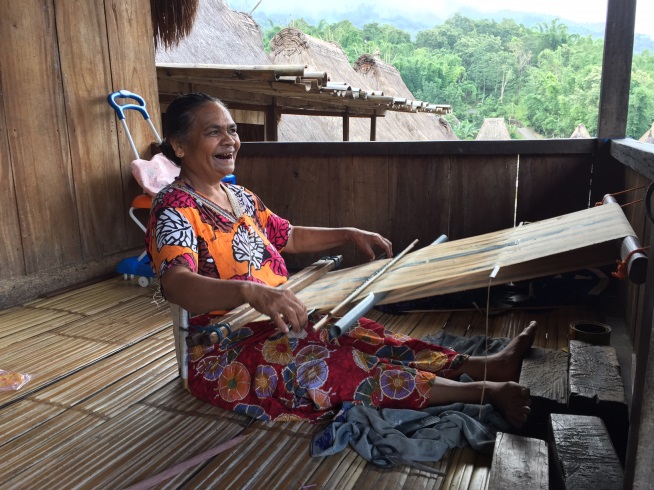 The village was set in a stunning location, with the dormant volcano Mt Inerie (pronounced ee-nay-REE-ay) or “happy mother mountain” overlooking the site. Around were ravines, hillocks, forest, community and family gardens. The fragrant smell of blooming coffee flowers filled the air. From the south end of the village you could see down the Jerebuu valley to the sea. In the distance to the east was the local district town of Jerebuu, where I later saw the teenagers of Bena hanging around the intersections. See my video here https://facebook.com/KonJenMakassar/videos/1141928045936574/
The village was set in a stunning location, with the dormant volcano Mt Inerie (pronounced ee-nay-REE-ay) or “happy mother mountain” overlooking the site. Around were ravines, hillocks, forest, community and family gardens. The fragrant smell of blooming coffee flowers filled the air. From the south end of the village you could see down the Jerebuu valley to the sea. In the distance to the east was the local district town of Jerebuu, where I later saw the teenagers of Bena hanging around the intersections. See my video here https://facebook.com/KonJenMakassar/videos/1141928045936574/
How do traditional villages like this survive? Partly from a small but growing tourism industry. In the peak season (June-August) up to 200 visitors a day – Europeans, Australians, folk from Jakarta – visit the village, pay an entrance fee and buy traditional handicrafts. It is hard to get to, but clearly a lot of people think it is worthwhile.
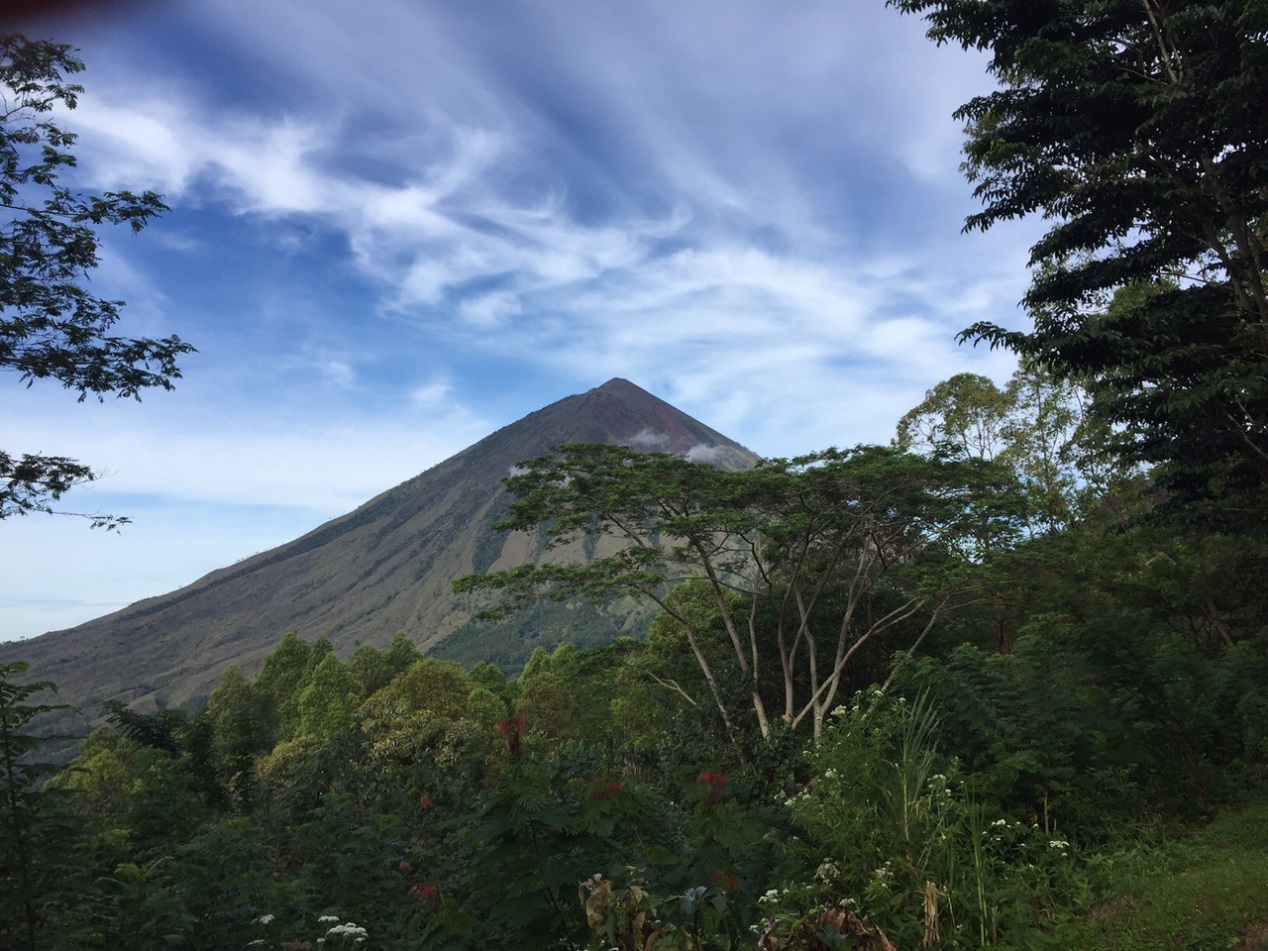
Mt Inerie, Jerebuu Valley, Ngada Regency, Flores
